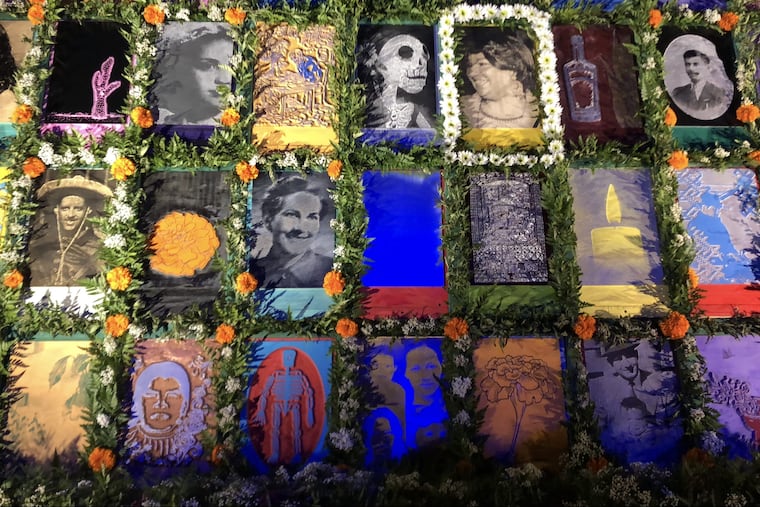Saints, rum, and altars: How religion and country shape Philly Latinos’ Day of the Dead celebrations
Some carry images of deities and deceased loved ones to connect with them and their homeland roots.

In an empty hallway of Miguel Peralta's house hangs a picture of the Virgin of Altagracia.
The portrait of the Virgin Mary who protects all Dominicans — important enough that he made sure it was carefully packed in his luggage when he left his homeland seven years ago — hangs where only trustworthy guests can see it. Why so hidden?
"To venerate her, to feel that she protects our home, without having others misunderstand our beliefs," said Peralta, 45.
Peralta, born and raised Catholic, also keeps smaller images of the Virgin of Altagracia that he can carry with him in his pocket, as well as an image of the Catholic St. Miguel — who, in the Nigerian Yoruba religion, is a spirit. Named after the saint, Peralta says he worships these Catholic and Yoruba figures because they have guided his journey from the island to his life in the United States, where he arrived in 2009 to invest in grocery stores.
"I would have never gotten this far if it weren't for the blessings that the Virgin, Jesus, and the saints provide," he said.
For Latinos in the United States — two-thirds of whom are Catholic (although in Philadelphia, most classify themselves as unaffiliated) — religious beliefs often coexist with the worship of more homeland-specific deities, creating cross-cultural traditions that combine Catholicism with ancestral rituals of Native Americans and spiritual practices brought by African slaves.
These can take the form of altars, sculptures, and paintings; music and dance; funeral rites and healing practices; in memoriam cards, or resguardos, a kind of amulet that might provide luck, fortune, or protection from bad vibes — all serving to link Latinos to the countries from which they came.
On the Day of the Dead — a holiday celebrated Nov. 1 and 2 that honors the souls of deceased loved ones and saints — they take on even more significance.
Eva, 49, who goes by "La Doña," a spiritual healer from the Dominican Republic, owns a Northern Liberties botánica, a shop that sells, among other things, candles, sculptures, herbs, and oils for spiritual cleansing. She says all people have "a light, a vibe," that determines which saint they should carry in their wallets.
In the Afro-Caribbean religion Santería, based on Yoruba beliefs and traditions, she named Yemayá (La Virgen de Regla), who protects against bad vibes; Ochun (La Virgen de la Caridad del Cobre), who brings good luck; and Changó (St. Barbara), who provides energy, power, and fame. But there are thousands more.
These days, she also sees a growing number of Americans coming to her shop for vibe cleansing and good luck hugs.
But such beliefs can clash with established doctrines, whether here or abroad, resulting in a desire to keep them under wraps.
Most people won't show just anyone what's in their wallets.
Mexicans, though, openly celebrate the Day of the Dead. In the most mainstream American acknowledgment of the holiday — the 2017 movie Coco — they're portrayed preparing a trail to welcome their Aztec ancestors with a celebration featuring colorful altars, flowers, food, and music.
In Caribbean countries like Cuba, Puerto Rico, and the Dominican Republic, people walk sorrowfully to the cemetery, lighting candles for each relative, pouring rum at the graves, and wearing dark-neutral colors. Back home are altars with flowers, candles, incense, and a large portrait or small in memoriam card that people carry in their wallets or pockets during the rest of the year.
"Our societies, especially of the Antilles, are societies of migration, and part of our cultural resistance is to carry with us what we share as ours on the islands and homeland," said Martín Cruz Santos, cultural historian and associate professor at Metropolitan University in San Juan, Puerto Rico.
The tradition of carrying pictures of saints and the dead dates to medieval Europe, when the Catholic Church began to print prayer cards with the image of a saint or the Virgin Mary, an inexpensive way to establish a connection with the faithful. People in rural areas who couldn't travel to a church took these images and combined them with sacred native and African deities that they carried with them.
In Philadelphia, the first one to adopt the Latino practice was St. John Neumann, who used to carry small portraits of saints in his pockets to give to children, according to Cruz Santos.
"You always carry the ones you love with you," Peralta said of the prayer card, or recordatorio, of his grandmother, who died 18 years ago. He's kept it with him since the day of her funeral.
Cruz Santos said that although Latinos may want to assimilate, their cultural traditions can inspire fear or distrust in non-Latinos — especially in this time of heightened nationalism. Sometimes, Latinos end up having to adapt and choose between the two.
When Cristina Martínez's 23-year-old son, Isaías, died of a heart attack in January 2017, it was up to her, owner of South Philly's Barbacoa, to fulfill his wishes to be buried here instead of in Mexico. She decided to have an American-style funeral.
"Everyone in the community came to the burial, because it was the first time for them to see such a thing," Martínez, 48, said of the nontraditional funeral: They took the coffin to the burial site, laid it in the ground and threw dirt on it. Unlike at a Mexican funeral, there was no music.
This week, because she knew her restaurant would be packed on Thursday and Friday with Day of the Dead observers, she visited his grave on Tuesday.
With her, she brought tequila, barbacoa, tortillas, candy, and spices.